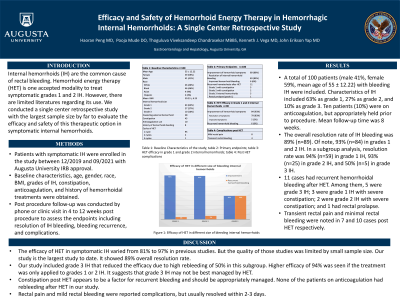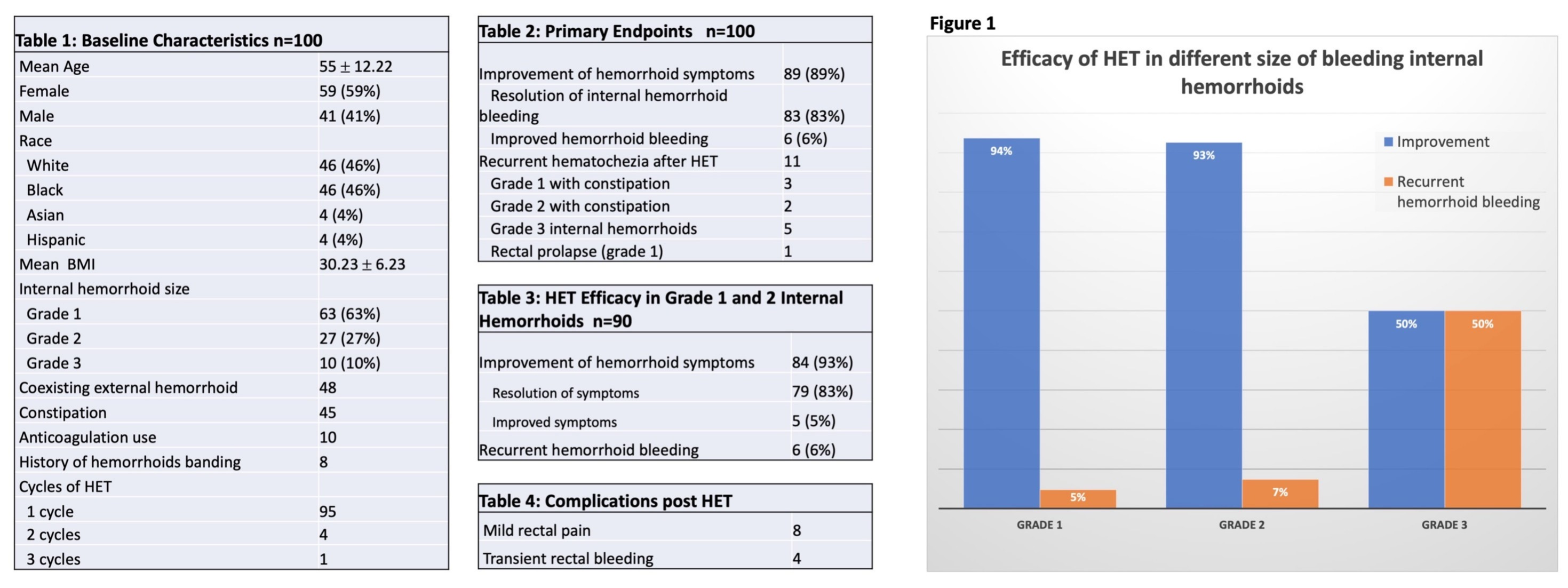Back


Poster Session A - Sunday Afternoon
Category: GI Bleeding
A0293 - Efficacy and Safety of Hemorrhoid Energy Therapy in Hemorrhagic Internal Hemorrhoids: A Single Center Retrospective Study
Sunday, October 23, 2022
5:00 PM – 7:00 PM ET
Location: Crown Ballroom

Has Audio

Haoran Peng, MD
Augusta University Medical College of Georgia
Augusta, GA
Presenting Author(s)
Award: Presidential Poster Award
Haoran Peng, MD1, Pooja Mude, DO2, Viveksandeep Chandrasekar, MBBS2, Kenneth J. Vega, MD, FACG2, John Erikson L. Yap, MD2
1Augusta University Medical College of Georgia, Augusta, GA; 2Augusta University Medical College of Georiga, Augusta, GA
Introduction: Internal hemorrhoids (IH) are a common cause of rectal bleeding. Hemorrhoid energy therapy (HET) is one accepted modality to treat symptomatic grades 1 and 2 IH. However, there are limited literatures regarding its use. We conducted a single center retrospective study with the largest sample size by far to evaluate the efficacy and safety of this therapeutic option in symptomatic internal hemorrhoids.
Methods: We retrospectively included patient encounters with symptomatic IH between 12/ 2019 and 09/2021 with Augusta University IRB approval. Baseline characteristics, including age, gender, race, BMI, grades of IH, constipation, anticoagulation, and history of hemorrhoidal treatments were obtained. Post procedure follow-up was conducted by phone or clinic visit in 4 to 12 weeks post procedure to assess the endpoints including resolution of IH bleeding, bleeding recurrence, and complications.
Results: A total of 100 patients (male 41%, female 59%, mean age of 55 ± 12.22) with bleeding IH were included. Characteristics of IH included 63% as grade 1, 27% as grade 2, and 10% as grade 3. Ten patients (10%) were on anticoagulation, but appropriately held prior to procedure. Mean follow-up time was 8 weeks.
The overall resolution rate of IH bleeding was 89% (n=89). Of note, 93% (n=84) in grades 1 and 2 IH. In a subgroup analysis, resolution rate was 94% (n=59) in grade 1 IH, 93% (n=25) in grade 2 IH, and 50% (n=5) in grade 3 IH. 11 cases had recurrent hemorrhoidal bleeding after HET. Among them, 5 were grade 3 IH; 3 were grade 1 IH with severe constipation; 2 were grade 2 IH with severe constipation; and 1 had rectal prolapse.
Transient rectal pain and minimal rectal bleeding were noted in 7 and 10 cases post HET respectively.
Discussion: The efficacy of HET in symptomatic IH varied from 81% to 97% in previous studies. But the quality of those studies was limited by small sample size. Our study is the largest study to date. It showed 89% overall resolution rate. Our study included grade 3 IH that reduced the efficacy due to high rebleeding of 50% in this subgroup. Higher efficacy of 94% was seen if the treatment was only applied to grades 1 or 2 IH. It suggests that grade 3 IH may not be best managed by HET. Constipation post HET appears to be a factor for recurrent bleeding and should be appropriately managed. None of the patients on anticoagulation had rebleeding after HET in our study. Rectal pain and mild rectal bleeding were reported complications, but usually resolved within 2-3 days.

Disclosures:
Haoran Peng, MD1, Pooja Mude, DO2, Viveksandeep Chandrasekar, MBBS2, Kenneth J. Vega, MD, FACG2, John Erikson L. Yap, MD2. A0293 - Efficacy and Safety of Hemorrhoid Energy Therapy in Hemorrhagic Internal Hemorrhoids: A Single Center Retrospective Study, ACG 2022 Annual Scientific Meeting Abstracts. Charlotte, NC: American College of Gastroenterology.
Haoran Peng, MD1, Pooja Mude, DO2, Viveksandeep Chandrasekar, MBBS2, Kenneth J. Vega, MD, FACG2, John Erikson L. Yap, MD2
1Augusta University Medical College of Georgia, Augusta, GA; 2Augusta University Medical College of Georiga, Augusta, GA
Introduction: Internal hemorrhoids (IH) are a common cause of rectal bleeding. Hemorrhoid energy therapy (HET) is one accepted modality to treat symptomatic grades 1 and 2 IH. However, there are limited literatures regarding its use. We conducted a single center retrospective study with the largest sample size by far to evaluate the efficacy and safety of this therapeutic option in symptomatic internal hemorrhoids.
Methods: We retrospectively included patient encounters with symptomatic IH between 12/ 2019 and 09/2021 with Augusta University IRB approval. Baseline characteristics, including age, gender, race, BMI, grades of IH, constipation, anticoagulation, and history of hemorrhoidal treatments were obtained. Post procedure follow-up was conducted by phone or clinic visit in 4 to 12 weeks post procedure to assess the endpoints including resolution of IH bleeding, bleeding recurrence, and complications.
Results: A total of 100 patients (male 41%, female 59%, mean age of 55 ± 12.22) with bleeding IH were included. Characteristics of IH included 63% as grade 1, 27% as grade 2, and 10% as grade 3. Ten patients (10%) were on anticoagulation, but appropriately held prior to procedure. Mean follow-up time was 8 weeks.
The overall resolution rate of IH bleeding was 89% (n=89). Of note, 93% (n=84) in grades 1 and 2 IH. In a subgroup analysis, resolution rate was 94% (n=59) in grade 1 IH, 93% (n=25) in grade 2 IH, and 50% (n=5) in grade 3 IH. 11 cases had recurrent hemorrhoidal bleeding after HET. Among them, 5 were grade 3 IH; 3 were grade 1 IH with severe constipation; 2 were grade 2 IH with severe constipation; and 1 had rectal prolapse.
Transient rectal pain and minimal rectal bleeding were noted in 7 and 10 cases post HET respectively.
Discussion: The efficacy of HET in symptomatic IH varied from 81% to 97% in previous studies. But the quality of those studies was limited by small sample size. Our study is the largest study to date. It showed 89% overall resolution rate. Our study included grade 3 IH that reduced the efficacy due to high rebleeding of 50% in this subgroup. Higher efficacy of 94% was seen if the treatment was only applied to grades 1 or 2 IH. It suggests that grade 3 IH may not be best managed by HET. Constipation post HET appears to be a factor for recurrent bleeding and should be appropriately managed. None of the patients on anticoagulation had rebleeding after HET in our study. Rectal pain and mild rectal bleeding were reported complications, but usually resolved within 2-3 days.

Figure: Table 1: Baseline Characteristics of the study; table 2: Primary endpoints; table 3: HET efficacy in grade 1 and grade 2 internal hemorrhoids; table 4: Post HET complications; Figure 1: Efficacy of HET in different size of bleeding internal hemorrhoids
Disclosures:
Haoran Peng indicated no relevant financial relationships.
Pooja Mude indicated no relevant financial relationships.
Viveksandeep Chandrasekar indicated no relevant financial relationships.
Kenneth Vega indicated no relevant financial relationships.
John Erikson Yap indicated no relevant financial relationships.
Haoran Peng, MD1, Pooja Mude, DO2, Viveksandeep Chandrasekar, MBBS2, Kenneth J. Vega, MD, FACG2, John Erikson L. Yap, MD2. A0293 - Efficacy and Safety of Hemorrhoid Energy Therapy in Hemorrhagic Internal Hemorrhoids: A Single Center Retrospective Study, ACG 2022 Annual Scientific Meeting Abstracts. Charlotte, NC: American College of Gastroenterology.

